Getting your Trinity Audio player ready...
The launch of Sputnik, the first artificial satellite in history, in October 1957, marked the starting point of the space age and the race between superpowers - the United States and the Soviet Union - to be the first to send a human into space. While the Soviet space program operated with a militaristic and secretive approach, the United States established a civilian space agency, NASA.
Read more:
President Dwight Eisenhower envisioned that space pilots could be civilians with education in science or engineering, with backgrounds in a variety of challenging occupations such as pilots, navigators, divers, submarine crew members, paratroopers, hot-air balloon pilots and more.
The idea was attractive, but since NASA was in a race against the Soviets and time was of the essence, the first head of the agency, Keith Glennan, decided to politely decline the presidential suggestion and opted instead to rely on a pre-vetted elite group that had already proven themselves in rigorous tests: military test pilots.
These pilots were trained to calmly handle malfunctions and crises and to operate at peak performance even in life-threatening extreme situations. And no less important, they had already undergone lengthy selection and training processes. All that remained was to select the most suitable candidates amongst them, conduct an additional medical screening and train the selected candidates for space flight.
The document that was approved by the president already stated that the space pilots would be men only, and the choice of test pilots precluded any practical possibility of changing this policy. The two main schools for test pilots, one for the Air Force and the Navy, accepted only combat pilots who, by definition - could only be men at the time.
14 View gallery
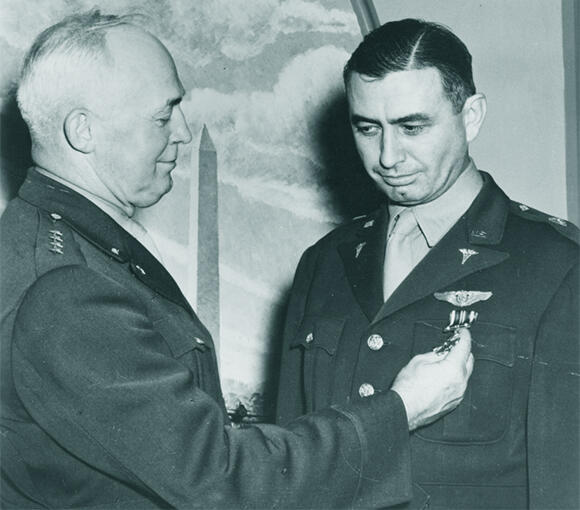

The doctor who wanted to send women to space. Randy Lovelace (right) receiving the Distinguished Flying Cross for his contribution to pilot safety during World War II
(Photo: U.S. Air Force)
Medical Screening
At the end of the 1950s, it was still unknown how spaceflight would affect the human body. Consequently, it was unclear which medical tests were necessary to perform in order to select the astronauts. The young space agency assigned the task of determining these tests to Randy Lovelace, an aviation physician who served in the U.S. Air Force during World War II. Lovelace had studied the effects of high-altitude flight, developed pilots' oxygen masks and equipment for high-altitude parachuting.
He also tested this equipment on himself, during a dive from a height of 13 kilometers, which nearly cost him his life and earned him a Distinguished Flying Cross. After the war, Lovelace managed a family clinic and a research institute in Albuquerque, New Mexico, while continuing his work in aviation and space with the Air Force, eventually becoming an advisor to the space agency.
Lovelace and his team compiled a grueling series of medical tests for the astronaut candidates, which lasted an entire week. These tests included comprehensive laboratory tests, full-body X-ray images, vision tests under various conditions, balance tests, endurance tests and more.
When John Glenn, who was selected as one of the first seven space pilots, was asked about the medical examinations during a press conference, he described them as follows: “If you figure how many openings there are on the human body and how far you can go into any one of them… you answer which would be the toughest for you?”
Test pilots who passed the medical screening were referred to psychiatric and psychological evaluation, which also involved spending extended periods in a completely dark and soundproof room. The next stage included tests that were specifically designed for astronauts, and were conducted in Air Force laboratories, involving simulations of extreme G-forces in a centrifuge, performance in simulated weightlessness, and orientation and performance testing under challenging conditions and in complex and unfamiliar situations.
Out of the thirty-two test pilots who passed the initial screening criteria for age, height, weight, education and flight experience, the space agency selected seven astronauts in 1959 for the first manned spaceflight program, Project Mercury.
14 View gallery
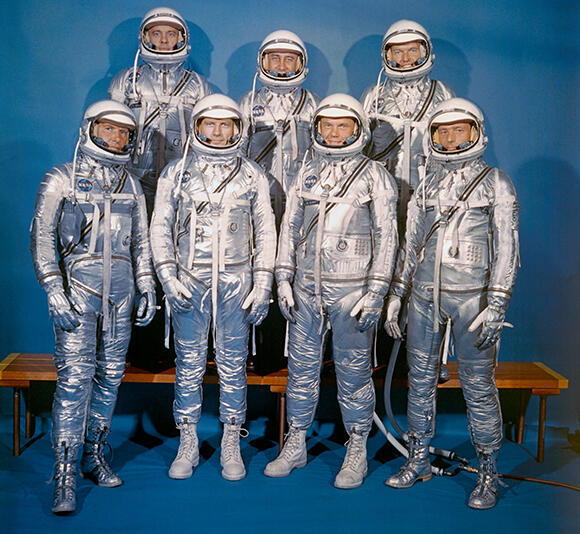

The Magnificent Seven. The pilots selected for Project Mercury. In the top row, from right: Gordon Cooper, Gus Grissom and Allen Shepard. In the bottom row, from right: Scott Carpenter, John Glenn, Deke Slayton and Wally Schirra
(Photo: NASA)
From The Hair Salon To The Sky
Once the astronauts were selected, Lovelace was curious to also examine women and test their fitness for space flight. He and several of his colleagues believed that women could be more suitable than men for space flight, in part because of their physical size and lower oxygen consumption. They approached NASA and the Air Force with a request to include women in the testing, but were met with refusal.
The prevailing view was that women lacked physical strength and resilience in extreme conditions, and their decision-making performance under stressful conditions was deemed too weak. Lovelace, who disagreed with these views, continued to search for ways to conduct tests for women without NASA’s support. Salvation came from his longtime friend, the legendary pilot Jackie Cochran.
Chocran was born in 1906 to a working class family from Florida. She married at the young age of fourteen and had a son, who died at the age of five, leading to the dissolution of her marriage. She worked as a hairdresser and after a few years moved to New York, where she changed her first name from Bessie to Jacqueline, and by doing so also turned her fortunes. She married millionaire Floyd Odlum and with his financial backing, founded a successful cosmetics company.
However, Cochran soon became enamored with aviation and lost all interest in cosmetics. She obtained her pilot’s license and became one of the most prominent and successful pilots in the United States. She participated and succeeded in aviation competitions, broke records, and collected awards.
During World War II, she recruited dozens of female pilots for the Air Force’s auxiliary unit for non-combat missions. The pilots of the Women Airforce Service Pilots (WASP) transported troops and cargo, relocated planes, and flew target planes during training exercises for male pilots.
Cochran dreamt of flying into space herself, even though she was in her fifties by the time Lovelace was developing the medical screenings for astronauts. When she heard of his plans to test women for space flight, she agreed to fund the medical tests for potential female astronauts out of her own pocket.
Lovelace and Cochran compiled a list of requirements that was even more stringent than those for male astronauts. They sought female pilots under thirty-five, in excellent physical condition and with extensive flying experience.
14 View gallery
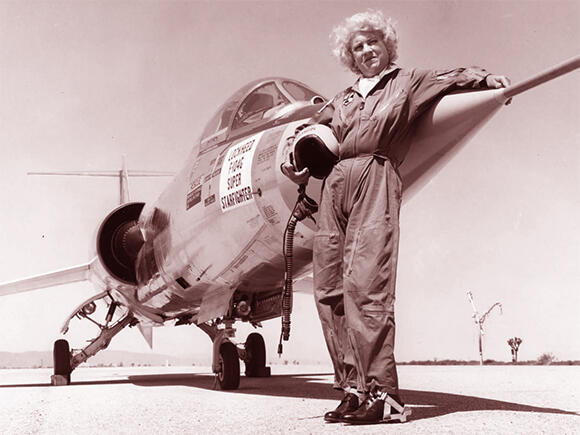

The hairdresser who became a pilot and financed the medical screens for female space pilots. Jackie Cochran
(Photo: San Diego Air & Space Museum)
The Ideal Candidate
Geraldine Cobb, who preferred to be called Jerry, was born in Oklahoma in March 1931. Her father, a military man and pilot, introduced her to aviation by taking her flying on his airplane when she was 12. From that point on, her passion for flying was ignited. By the age of seventeen she had obtained her private pilot license and on her eighteenth birthday, she earned her commercial pilot license. By nineteen Cobb was already a certified flight instructor, actively looking for employment in the aviation industry.
In the years following World War II, the American market was inundated with pilots returning from the war, making it difficult for women to secure employment in the aviation industry. Cobb would take on any job related to flying, including crop dusting or flying tours along oil pipelines. She eventually found her dream job a few years later, in Florida, at a company that acquired old military airplanes left over from the war and sold them to foreign air forces.
Cobb's role was to deliver these planes to their various destinations, anywhere from Peru to India, and then find her way back to the United States, where she would take off with another plane. This role demanded exceptional flying skills across numerous airplane models, proficient navigation abilities, adeptness in handling malfunctions, endurance for long solitary flights, and the capability to navigate through unpredictable circumstances. For instance, she once faced arrest in Ecuador while en route to deliver an airplane to the Peruvian air force, during a military conflict between the two nations.
While taking on these types of missions, Cobb also participated in flying competitions, setting several records for altitude, distance and speed. She became one of the most famous pilots in the United States, and when Lovelace offered her to undergo tests to become a space pilot, she readily accepted.
In February 1960, Cobb arrived at Lovelace’s clinic for a grueling week of medical tests, just like those for male astronauts, including performance during stress. Her results were no less impressive than those of the men, even surpassing most of them. Lovelace presented the results at a scientific conference in Sweden, and immediately after their publication many journalists named Cobb as the first American female astronaut, and were eager to photograph her next to a model of the Mercury spacecraft.
However, Lovelace knew that one woman was not enough to substantiate his claims that women were just as fit as men for space flight. With Cobb’s help, he compiled a list of additional female pilots and invited them to undergo the tests. In total he tested 19 additional pilots, and found 12 of them fit for space flight, when their test results were similar or better than those of the male astronauts.
Armed with this data Lovelace approached his colleagues in the Air Force, trying to convince them to allow “his” women to go through the astronaut flight tests. The Air Force firmly refused, stating, without much basis but with great determination, that women were not suitable for space flight. NASA also claimed that there was not enough knowledge about women's physiology, and it was not worth the time to investigate it now.
Meanwhile, Cobb decided to move things forward on her own. She contacted a psychiatrist from Oklahoma, Jay Shurley, who had developed his own assessment tools for astronauts, including replacing the dark room with an isolated water tank where subjects float in complete darkness. Cobb took his test, and was found mentally fit for space flight. In the flotation test, any result over six hours was considered excellent. Ultimately, the clinic staff stopped her test after more than nine hours, although she could have kept going and showed no signs of distress or anxiety.
Of the 13 women who passed Lovlace’s tests, only two more found the time and resources to fly to Oklahoma for the psychiatric test. Both of them, Wally Funk and Rhea Hurrle passed the tests with flying colors and lasted longer than ten hours in the isolation tank.
14 View gallery
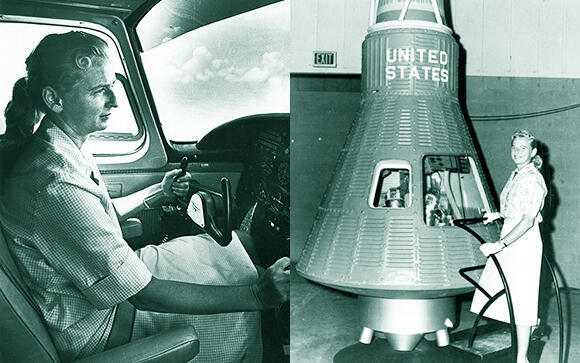

Better results than the male astronauts. Cobb in the cockpit and with a model of the Mercury spacecraft
(Photo: National Air and Space Museum, NASA, Public Domain)
Along Came Jackie
Finally Lovelace found a way to circumvent the Air Force’s refusal, and reached an agreement with the Naval Aerospace Medical Institute. The Navy agreed to allow Jerry Cobb to take the astronaut tests and committed to testing the additional female pilots if she passed them tests.
In April 1961, the Russians startled the Americans by launching the first human to space. Yuri Gagarin’s flight was a severe blow to NASA and to American pride. In the shadow of this event, Cobb attended the Naval Aerospace Medical Institute for ten days of grueling tests.
The evaluations included assessing her performance in zero gravity, orientation and flying with impaired equilibrium, high G-force endurance, escaping from a plane that crashed into water and more. At the end of the tests, it was clear that Cobb had succeeded impressively. Her results placed her in the top two percentile of the male astronauts.
In light of her success, the navy was supposed to test Lovlace’s other twelve female pilots. The date was set, and the women went to great lengths to make themselves available for over a week, arranging for family and work, with two even going as far as quitting their jobs to participate in the testing.
At this point Jackie Cochran, who had initially financed the medical tests for the potential female candidates for space flight, became involved. Cochran felt that Cobb, the natural leader of the group, was overshadowing her and that she was not receiving the media spotlight she deserved.
Cochran informed a senior officer in the Navy that the testing program was being conducted without NASA's consent. The officer sought clarification from the space agency, and upon learning that there were no plans to include women in space flights in the foreseeable future, canceled the planned tests for the additional twelve women.
Cobb and her partners did everything in their power to alter NASA’s decision. After the head of the agency, James Webb, refused to consider launching women into space, they managed to secure a meeting with the U.S. Vice President Lyndon Johnson, but he refused to intervene in the work practices of the space agency.
They even succeeded in promoting the founding of a special subcommittee hearing in the House of Representatives to address the claims about discrimination against women at NASA, but then Jackie Cochran, uninvited, appeared and stated that there was really no need for female astronauts, and that incorporating women into NASA at this time would only delay the all-male space program.
Following her statements, along with the testimony of astronaut John Glenn, who justified the discrimination by saying that it was just the natural social order, the committee concluded its hearings and determined that there was no issue with NASA’s astronaut selection process. American women would not fly to space for the time being.
14 View gallery
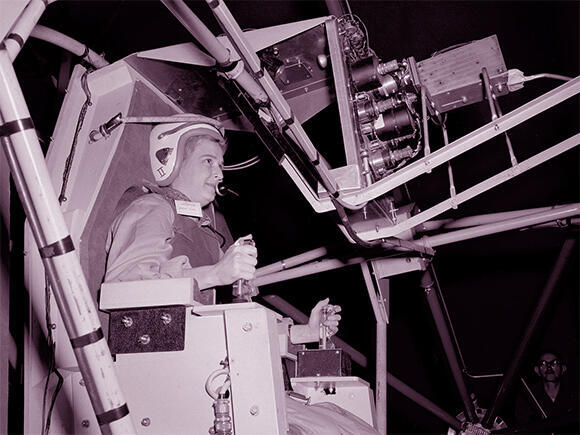

Excelled in tests for astronauts as well. Jerrie Cobb at the facility evaluating pilots' proficiency in handling rotation in three axes
(Photo: NASA)
The Communist Poster Girl
Meanwhile, while project Mercury advanced lazily, the Soviet Union’s Vostok program was sprinting ahead. Following Yuri Gagarin’s successful mission in Vostok 1, Gherman Titov completed a full day in space during the Vostok 2 mission. In the Vostok 3 mission the Soviets managed to surprise the world again, by launching the next spacecraft, marking the first time at which two manned spacecraft were in orbit around the Earth. In June 1963 the Soviets again launched two spacecraft two days apart. On the second spacecraft, Vostok 6, was the first woman to ever fly to space.
Valentina Tereshkova was born in 1937 in a small village, located a few hundreds of kilometers from Moscow. Her mother worked in a textile factory while her father was a tractor driver. The father, Vladimir, also served as a tank commander in the Red Army, and fell in battle during World War II, when she was two years old.
At a young age, she worked to help support her family, working in a tire factory and completed her high school education in the evenings. She later moved to work at the textile factory where her mother and her older sister worked. In her spare time she pursued further education by taking courses through correspondence, aspiring to become an engineer.
At the same time she was also active in the Communist Youth Movement, which conducted its activities in the factory. While doing all of this, Tereshkova also found time for an unusual hobby: skydiving. She joined a local skydiving club and quickly accumulated over a hundred jumps.
Following Gagarin and Titov’s successful space flights, Tereshkova - much like many young men and women in the Soviet Union - wrote a letter to the authorities in Moscow, offering her services as a cosmonaut.
Unbeknownst to her, the Soviets had already begun planning to send a woman into space. Media reports about Lovelace's testing of female spaceflight candidates led them to believe that their American rivals intended to send a woman to space and decided to beat them to it. The Soviet leadership never considered including women in their space program on an equal basis as in Lovelace's vision. For them, it was an opportunity for political propaganda, showcasing the Soviet Union's egalitarian vision, according to which anyone could fly to space, even a working-class woman.
In the Vostok spaceships the Soviets harbored reservations about relying solely on parachutes for landing. Consequently, upon the spacecraft's descent, an ejector seat would be engaged, which would eject the astronauts from the spaceship to land separately, in order to ensure greater safety. Since the spaceship had an automatic flight system, they did not necessarily look for experienced pilots, rather, they prioritized women with extensive skydiving experience.
Tereshkova was selected along with five other young women, out of more than 400 candidates, for a training program to become the first female cosmonaut. In March 1962 the women were enlisted into military service, and underwent training similar to their male cosmonaut counterparts. The training program was fairly similar to the American tests: coping with extreme temperatures, prolonged isolation in a dark soundproof room, performance in zero gravity in a diving plane, skydiving training on land and at sea, and flight training. Five out of the six women successfully completed the training.
The original plan was to launch two spacecraft shortly apart, each with a woman aboard, but ultimately, the Soviets decided to settle for only one woman. Tereshkova did not have the best scores in the tests and was ranked last among the five in many areas. However, political considerations came into play: her background was very perfectly aligned with the message that Soviets wanted to convey, a young woman from a poor, working-class family, with little formal education and a strong desire to learn, a loyal communist who lost her father in the war.
Another consideration was the candidate’s ability to speak in front of an audience and promote the communist messages to the world. Here too she had a significant advantage, and she was able to overcome candidates who might have been better suited for space flight. Thus, Tereshkova was chosen to be the first woman in space. Irina Solovyova was selected as the backup cosmonaut.
14 View gallery
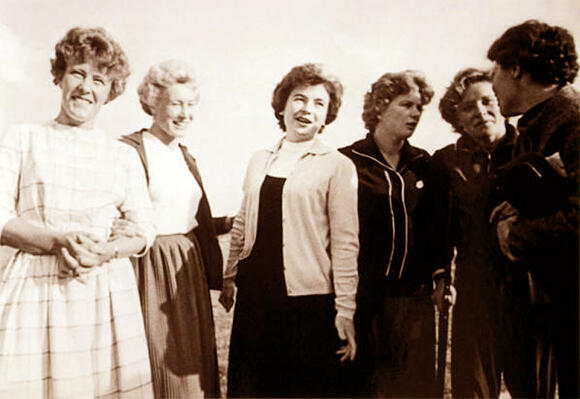

With no intention to provide women with an equal opportunity of spaceflight. Tereshkova (fourth from the left) with the female cosmonauts who did not fly to space
(Photo: NASA)
Hardship In Space
On June 14, 1963, the Vostok 5 spacecraft was launched, and two days later, on June 16, Vostok 6 was launched with Tereshkova on board, who became the first woman in space. In honor of the flight, the Soviet military promoted her from the rank of private to lieutenant, and also to captain during her flight.
Tereshkova experienced discomfort in space, suffering from pains and nausea when attempting to eat. She later attributed this not to her physical condition, but to the taste of the food. Adding to her discomfort, the team who packed her equipment forgot to pack a toothbrush, making her situation particularly unpleasant. Despite these challenges, she performed various tasks, including taking photographs of the Earth from space and conversing over the radio with the leader of the Soviet Union, Nikita Khrushchev.
When asked to attempt manual control of the spacecraft, she discovered a malfunction in the orientation system and reported it to the mission control center. If it were not for her awareness, Tereshkova might have faced a fatal outcome in space, or a far more dangerous landing. She eventually parachuted as planned into the wilderness of the steppes of Kazakhstan, after nearly three full days in space.
Tereshkova was asked not to speak about the life threatening malfunction and indeed she kept it secret. It was only made public many years later, after the collapse of the Soviet Union.
Following her spaceflight, Tereshkova became a star, representing the Soviet Union around the world. She remained in the space program as an instructor, completed her academic studies, advanced in the military ranks and was later elected to the Duma, the lower house of the Russian parliament. However, her success did not lead to the improvement of women’s status in the space program. She never flew to space again and none of the other four female cosmonauts who were trained alongside her ever flew to space.
Five months after her spaceflight Tereshkova married another cosmonaut, Andrian Nikolayev, who flew on the Vostok 3 mission. In June 1964, about one year after her return from space, their daughter Yelena was born - the first person in history whose both parents had flown to space. The healthy baby girl also refuted one of the arguments of those who objected to women flying into space, the concern about their fertility.
14 View gallery
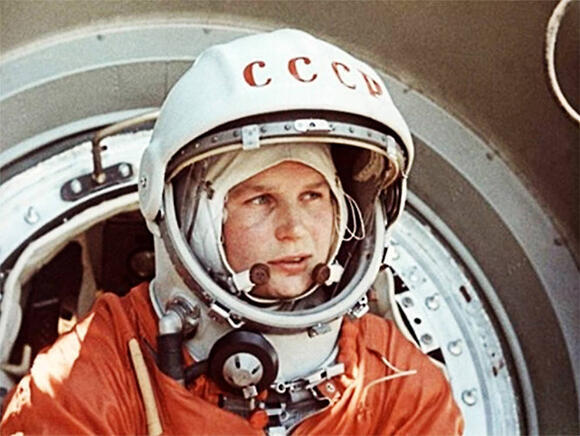

Never flew to space again, Tereshkova in her spacesuit on her way to the historical mission
(Photo: NASA)
The Pilot Before The Passenger
In the 60s and early 70s, the superpowers’ space activities focused on the race to the moon, and on developing space stations. In the mid-70s, the Americans began developing the Space Shuttle, which was much larger than previous spacecrafts and capable of carrying seven crew members, compared to only three in the Apollo and Soyuz spacecrafts. Additionally, the shuttle required only two pilots to fly, leaving room for five astronauts who did not need to pilot it and could focus solely on conducting experiments and research.
In anticipation of the Shuttles' operation, NASA recruited in 1978 a new class of astronauts, and this time it was open not just to male pilots or white individuals. Out of more than 8,000 applicants, 35 candidates were selected, including six women: Anna Fisher, Shannon Lucid, Judith Resnik, Sally Ride, Rhea Seddon and Kathrin Sullivan. Completion of the Shuttles was delayed, and test flights began only in 1981. A year later, an American woman was assigned for the first time to a space flight, which was intended for launch in June 1983, exactly 20 years following Tereshkova’s flight.
However, the Soviet Union had no intention of allowing the Americans to gain space achievements without reminding the world of their presence. Following the recruitment of women to NASA’s 1978 astronaut group, the Soviets also secretly recruited a group of five female physicians and five female engineers. Nine of them completed the official training but were not assigned to a space mission, and carried on working in their regular jobs.
With the announcement of the first American woman’s spaceflight, the Soviets declared that they would launch another woman into space before then, for a mission to the Salyut 7 space station. Due to time constraints, the Soviets chose the most qualified engineer in the field of flight, an area in which Svetlana Savitskaya, a 33-year-old aeronautical engineer, was unrivaled.
Savitskaya, the daughter of a high ranking officer in the Soviet Air Force, discovered skydiving at age 16 and performed hundreds of jumps, including from altitudes of 13 and 14 kilometers. She studied engineering at the Moscow Aviation Institute, obtained her pilot’s license, and later became a qualified flight instructor and test pilot, working for the Yakovlev aircraft company. She was also a member of the Soviet Union’s aerobatics team, which won competitions worldwide.
In August 1982 Savitskaya and two of her male colleagues were launched on the Soyuz T-7 mission, spending eight days on the Salyut 7 space station. She later recounted in an interview that when she entered the station, the two cosmonauts who were already there handed her a kitchen apron and said “get to work”. However, she was quickly able to establish professional working relationships with them.
Savitskaya conducted many experiments in space, many of them on herself, since apart from the limited knowledge gathered during Tereshkova’s flight, there were no medical data regarding the physiology and functioning of the female body in space. This time there was an opportunity to compare the data from men and a woman who stayed in the same conditions during the same time. She performed well in space, no less than her male colleagues, but did not excel afterwards in facing the media and public events, preferring to avoid public exposure.
14 View gallery
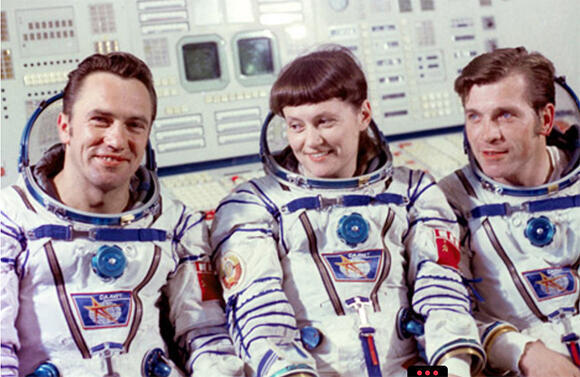

Refused to accept the apron. Savitskaya with her colleagues on the Soyuz T-7 mission, during preparations for launch
(Photo: ITAR-TASS)
No Crying In Space
When the Americans had to choose which of the six women would fly to space first, their choice fell on Sally Ride. She was highly skilled in operating the Shuttle’s robotic arm, which she also helped develop, and excelled in teamwork and in her role at mission control as a communicator with astronauts in space. Additionally, NASA believed that her strong character would help her to handle the media pressure.
“Do you cry when you have problems with the simulator? What type of makeup will you take to space? How will you deal with your period during a space mission? Do you intend to have children?” These were just some of the questions addressed to her in interviews prior to the upcoming space flight.
Ride was born in 1951 in Los Angeles, and from a young age she stood out as a good student in science and an outstanding athlete. After high school she pursued a dual bachelor’s degree in physics and English literature, and at one point paused her studies to pursue a professional career in tennis. After returning to the university she continued to a master's degree and then a doctorate in astrophysics. Near the completion of her doctorate she saw an ad by NASA, submitted her candidacy, and thus became the first American woman in space.
14 View gallery
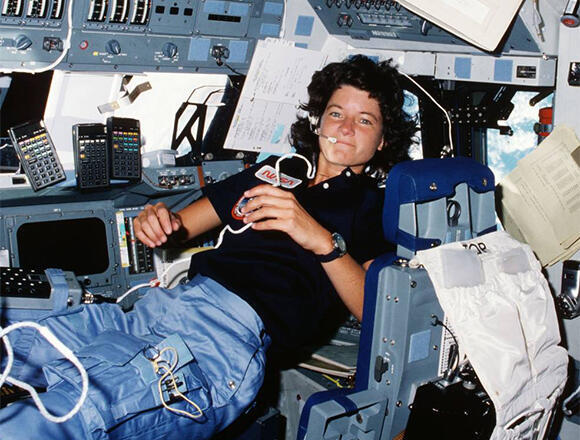

High skill and strong character. Ride on board the Space Shuttle Challenger during her first mission
(Photo: NASA)
Ride took part in the seventh mission of the Space Shuttle, got along great with the crew and together they completed all mission objectives and landed safely after six days in space. “I'm sure it was the most fun I'll ever have in my life”, she said upon her return to Earth.
It quickly became apparent that she was set to repeat this enjoyable experience, when she was assigned to another flight of the Space Shuttle Challenger on October 1984, this time with another female crew member - Kathrin Sullivan, who was destined to become the first woman in history to perform a “spacewalk” - that is, to exit the shuttle in a spacesuit to perform work outside the shuttle.
Ride was poised to become the first woman to fly to space twice, but her assignment once again spurred the Soviets into action. In July 1984 Savitskaya was launched again to the Salyut 7 space station, again with two men, for a mission that lasted 12 days. During this mission she spent 3.5 hours outside the station, successfully completing dangerous welding assignments. Thus, she not only preceded Ride by becoming the first woman to fly to space twice, but also beat Sullivan by becoming the first woman to perform a spacewalk. When Ride and Sullivan were launched in October 1984, it was the first space flight with two women on board.
14 View gallery
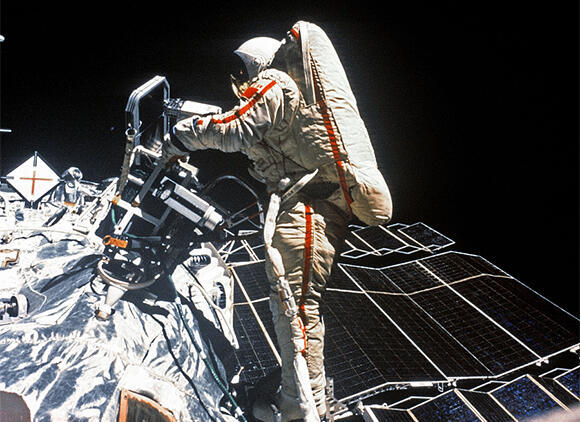

The first spacewalk by a woman. Savitskaya working outside the Salyut 7 space station
(Photo: Roscosmos)
In the following year Savitskaya was appointed as the commander of the first all-woman mission. This was also intended to be a flight to the Salyut 7 space station, but a series of malfunctions at the station led to the mission’s postponement and ultimately its cancellation. Of the nine women who were certified as cosmonauts in 1980, Savitskaya was eventually the only one who flew to space.
During those years NASA was relentlessly looking for projects that would raise public interest. One such project was the idea to launch a teacher into space, who would conduct classes from there in an effort to spark teenagers' interest in the space program. Out of over 10,000 male and female candidates, Christa McCullough was ultimately chosen and assigned to a mission on board the Space Shuttle Challenger.
Another woman on the crew was Judith Resnik, who had already flown to space once, and was the first Jewish woman in space. However, shortly after liftoff the Space Shuttle Challenger exploded, and Resnik and McCullough entered history from the tragic side, becoming the first women to die on a space mission, alongside their five male cremates.
14 View gallery
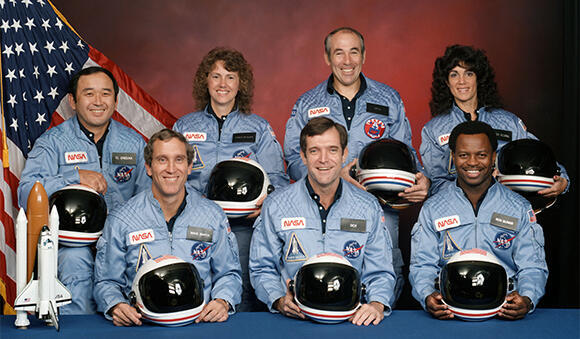

The first women to have died during a space mission. Resnik (right) and McCullough with their fellow crew members of mission STS-51, who perished in the Space Shuttle Challenger disaster
(Photo: NASA)
The First Female Pilot
In the 90s, women ostensibly had an equal status in NASA. Female astronauts participated in every space shuttle mission, but as passengers, not as pilots. That too was about to change.
Eileen Collins was born in 1956 in a small town in the state of New Youk, and by the age of 22 she had already completed her master’s degree in mathematics and economics. At this point she decided to change course in her life and joined the Air Force’s flight training program, which had been opened to women only five years prior.
After completing her training, she became a flight instructor on jet aircrafts, and later a test pilot in the Air Force. In 1990 she was selected as an astronaut, and in 1995 she finally got to fly to space, making history as the first woman to not only fly on board the Space Shuttle but also pilot it.
The mission included a maneuver around the Russian space station Mir, coming within only 11 meters of the space station, and the pilots performed the complex maneuver to perfection. Collins used the public attention garnered by the first mission of a woman as a Shuttle pilot to make a beautiful gesture by inviting the women who, over thirty years prior, had passed Lovelace's tests. Seven of them attended to see her fulfilling their old dream.
14 View gallery
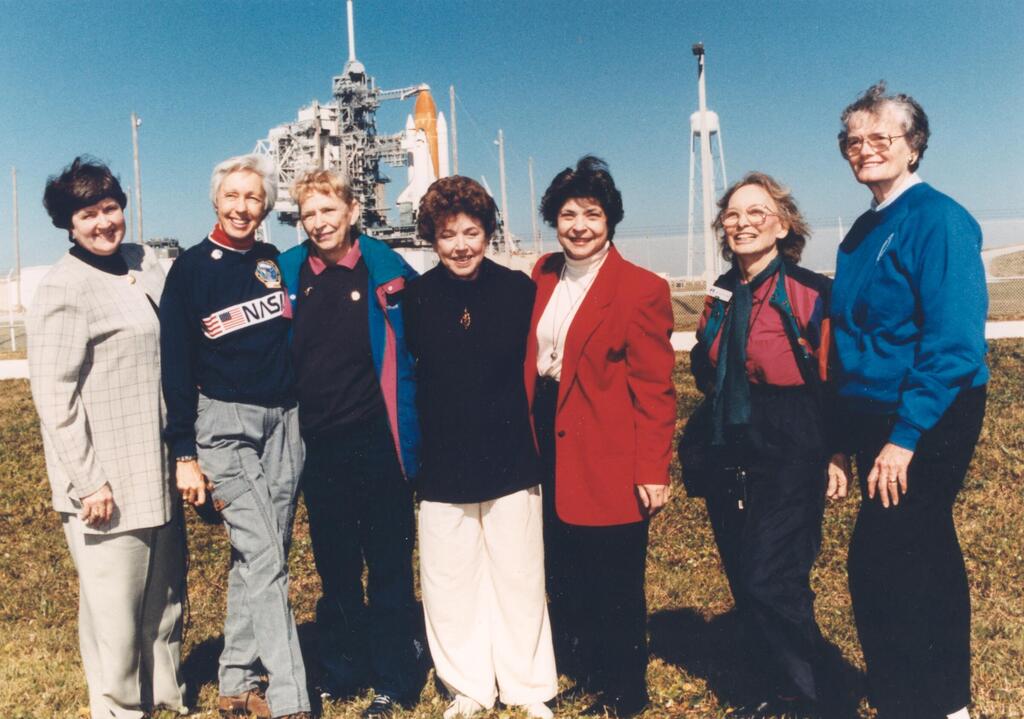

Seven of the women who passed Lovelace’s tests against the backdrop of Collins’s space shuttle, 1995. From left: Gene Nora Jessen, Wally Funk, Jerrie Cobb, Jerri Truhill, Sarah Rutley, Myrtle Cagle and Bernice Steadman
(Photo: NASA)
Collins flew again to space in 1997, as a pilot on the Space Shuttle Atlantis, this time docking with the Mir space station. After two successful missions as a pilot, her turn came to take the left seat in the shuttle cockpit, and in July 1999, the first space shuttle under the command of a woman was launched. She had successfully completed the complex assignment of deploying a large space telescope, despite malfunctions during launch, and was even awarded a medal for this achievement.
In 2000 Collins gave birth to her son Luke, and after returning from maternity leave, was appointed as the commander of another space shuttle mission. However, the mission was postponed several times due to malfunctions in the shuttles. On February 1st 2003, the Space Shuttle Columbia disintegrated upon its return to Earth, killing all seven crew members, including the first Israeli astronaut, Ilan Ramon.
Space shuttle flights were suspended for more than two years and Collins was assigned with the task of commanding the first and difficult shuttle mission following the disaster. Once again, she did so with great success and was also the first person to fly a space shuttle in a 360-degree rotation around the space station, to allow the station crew to photograph the underside of the shuttle and examine whether damage was caused to the insulation tiles during launch.
Despite the semblance of equality, only two women other than Collins ever piloted a space shuttle: Suzann Kilrain who only flew twice, and Pamela Melroy - the only other woman besides Collins to command a space shuttle, who currently serves as the Deputy Administrator (second in command) of NASA.
14 View gallery
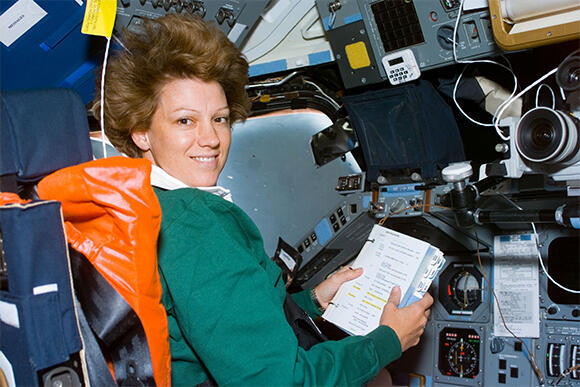

Successfully handled complex missions. Collins in the commander’s seat on the shuttle during her first mission as commander in 1999
(Photo: NASA)
Not Stopping At The Station
One of the Shuttle's most important tasks was to assemble the International Space Station (ISS). The station has been continuously manned since 2000, with crews typically staying on board for about six months. The first woman on board the station was Sussane Helms, an engineer in the U.S Air Force who flew four times on space shuttles, and her fifth mission was part of the the second crew to man the station, in 2001.
The next woman arrived at the station about one year later. Peggy Whitson was born to a family of farmers in Iowa in 1960. When she was nine, after watching the first humans to walk on the surface of the moon, she decided she too would be an astronaut. She studied biology and chemistry at the university, continued to a Ph.D. in biochemistry, and then joined NASA as a scientist, advising and supervising experiments that scientists requested to send to space.
Only after seven years of working as a scientist at NASA, in 1996, she was selected as an astronaut and had to wait another six years to finally fly to space. In June 2002 she flew on a shuttle to become a member of the fifth crew on board the space station.
In October 2007 Whitson returned to the station, this time as the commander of its sixteenth crew - becoming the first woman to command the space station. Upon her return to Earth she was appointed as the head of NASA’s Astronaut Office - the director of all of the agency’s astronauts. She was the first woman to hold the position and also the first person in this position who was not a pilot.
14 View gallery
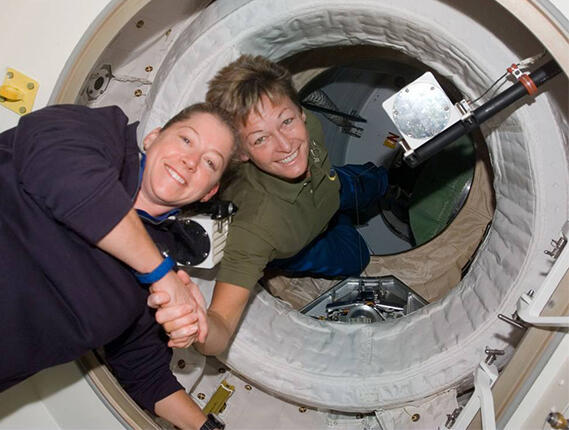

Sisterhood in space. The first female commander of the space station, Peggy Whitson, welcoming the second female commander, Pam Melroy, 2007
(Photo: NASA)
She arrived at the space station for the third time in November 2016 and is currently the only woman to have commanded it twice, out of four commanders in total. At the age of fifty six she was also the oldest woman to fly to space, and when she completed her mission in September 2017, she was the American who has spent the most amount of time in space, and also recorded ten spacewalks with a total duration of 60 hours.
That's not all. After retiring from NASA, she joined the company Axiom, which is building the first privately owned space station, which is based on the International Space Station. In early 2023 she returned to the ISS on Space-X’s Dragon spacecraft, as the commander of the second private mission to the space station.
To date, 73 women have flown to space, which accounts for 12 percent of all astronauts. This is far less than their share of the population, but much more than what Jerry Cobb and her companions dreamed of during the early days of their journey.
At the end of 2021, NASA selected the 23rd group of astronauts, which includes five men and five women, and at the end of 2022 the European agency selected a new group of astronauts that included nine men and eight women. After over 60 years of human presence in space, and thanks to many women who did not give up on their dreams, we can hope that we are on the path to full equality in space.

